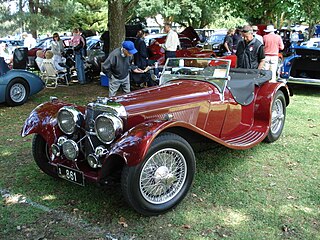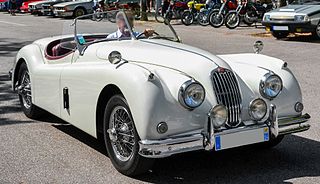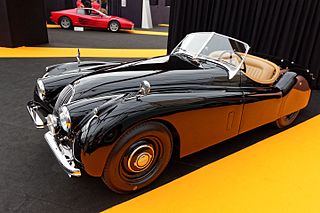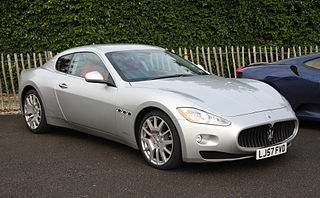
The Jaguar XK is a two-door 2+2 grand tourer manufactured and marketed by British automobile manufacturer Jaguar Cars from 1996–2014 in hatchback coupé and convertible body styles, across two generations. The XK was introduced at the Geneva Motor Show in March 1996 and was discontinued in July 2014.

The Jaguar E-Type, or the Jaguar XK-E for the North American market, is a British front mid-engined sports car that was manufactured by Jaguar Cars Ltd from 1961 to 1974. Its combination of exceptional aesthetics, advanced technologies, high performance, and competitive pricing established the model as an icon of the motoring world. The E-Type's claimed 150 miles per hour (240 km/h) top speed, sub-7-second 0 to 60 mph (97 km/h) acceleration, largely unitary body construction, front and rear independent suspension with disc brakes, mounted inboard at the rear, and rack-and-pinion steering, distinguished the car and spurred industry-wide changes.

The Jaguar XK150 is a sports car produced by Jaguar between 1957 and 1961 as the successor to the XK140.

The Maserati Quattroporte is a four-door luxury sports sedan produced by Italian automobile manufacturer Maserati. The name translated from Italian means "fourdoors". The car is in its sixth generation, with the first generation introduced in 1963.

The Jaguar XJ220 is a two-seat sports car produced by British luxury car manufacturer Jaguar from 1992 until 1994, in collaboration with the specialist automotive and race engineering company Tom Walkinshaw Racing. The XJ220 recorded a top speed of 212.3 mph (341.7 km/h) during testing by Jaguar at the Nardo test track in Italy. This made it the fastest production car from 1992 to 1993. According to Jaguar, an XJ220 prototype managed a Nürburgring lap time of 7:46.36 in 1991 which was faster than any production car lap time before it.

The Jaguar Advanced Lightweight Coupe (ALC) is a sports coupé concept car first shown at the 2005 North American International Auto Show in Detroit by the British automobile manufacturer Jaguar, then part of Ford's Premier Automotive Group.

The Jaguar Sport XJR-15 is a two-seater sports car produced by JaguarSport, a subsidiary of Jaguar and Tom Walkinshaw Racing between 1990 and 1992. Only 50 were planned, each selling for £500,000.

The SS Jaguar 100 is a British 2-seat sports car built between 1936 and 1939 by SS Cars Ltd of Coventry, England. The manufacturer's name 'SS Cars' used from 1934 maintained a link to the previous owner, Swallow Sidecar, founded in 1922 by Walmsley and Lyons to build motorcycle sidecars. In March 1945 the S. S. Cars shareholders agreed to change the name to Jaguar Cars Limited.

The Audi RS 4 is the high-performance variant of the Audi A4 range produced by Audi Sport GmbH for AUDI AG, a division of the Volkswagen Group. It sits above the Audi S4 as the fastest, most sports-focused car based on the A4's "B" automobile platform. The RS 4 was reintroduced in 2012, based on the A4 Avant instead of the sedan as did the original model.

Maserati Ghibli is the name of three different cars produced by Italian automobile manufacturer Maserati: the AM115, a V8 grand tourer from 1967 to 1973; the AM336, a V6 twin-turbocharged coupé from 1992 to 1998; and the M157, an executive saloon from 2013 onwards.

The Jaguar XK140 is a sports car manufactured by Jaguar between 1954 and 1957 as the successor to the XK120. Upgrades included more interior space, improved brakes, rack and pinion steering, increased suspension travel, and telescopic shock absorbers instead of the older lever arm design.

The Jaguar XK120 is a sports car manufactured by Jaguar between 1948 and 1954. It was Jaguar's first sports car since SS 100 production ended in 1939.

The Mitsubishi Lancer Evolution X is the tenth and final generation of the Lancer Evolution, a sports sedan produced by Japanese manufacturer Mitsubishi Motors.

The Maserati GranTurismo and GranCabrio are a series of grand tourers produced by the Italian manufacturer Maserati, succeeding the Maserati Coupé and Spyder. The first generation GranTurismo (M145) was introduced at the 2007 Geneva Motor Show and was produced from 2007 to December 2019. It set a record for the fastest development of a car, going from design to production in just nine months. The model featured a 4.2-litre V8 engine initially, which was later upgraded to a 4.7-liter engine in the GranTurismo S variant. The GranTurismo MC, a racing version developed for the FIA GT4 European Cup, and the GranTurismo MC Sport Line, a customisation programme, were also part of the lineup.

The Jaguar F-Type (X152) is a series of two-door, two-seater grand tourers manufactured by British car manufacturer Jaguar Land Rover under their Jaguar Cars marque since 2013. The car's JLR D6a platform is based on a shortened version of the XK's platform. It is the so-called "spiritual successor" to the famous E-Type.

Jaguar's independent rear suspension (IRS) unit has been a common component of a number of Jaguar production cars since 1961, passing through two major changes of configuration up to 2006 and last used in the Jaguar XK8 and Aston Martin DB7. This article concentrates on the first generation Jaguar IRS, which firmly established the marque's reputation for suspension sophistication, combining as it did smooth ride with excellent roadholding and low levels of noise, vibration, and harshness (NVH). The two generations overlap in time due to their being used in both full size and sports models that were updated at different times.

The Jaguar XK is the second and final generation of the Jaguar XK 2+2 grand tourer manufactured and marketed by British automobile manufacturer Jaguar Cars under the X150 internal designation. The three-door fastback coupé debuted at the 2005 Frankfurt Motor Show with the 4.2-litre V8 engine of its predecessor, and the two-door convertible debuted in 2006 at the North American International Auto Show.

The Jaguar XK8 is a grand tourer launched by Jaguar Cars in 1996, and was the first generation of a new XK series. The XK8 was available in two-door coupé or two-door convertible body styles with the new 4.0-litre Jaguar AJ-V8 engine. In 1998, the XKR was introduced with a supercharged version of the engine. In 2003, the engines were replaced by the new 4.2-litre AJ34 engines in both the naturally aspirated and supercharged variations. The first-generation of the XK series shares its XJS-derived platform with the Aston Martin DB7, with both cars tracing their history back to an abandoned Jaguar development study in the mid-1980s known as XJ41/XJ42, which had been mooted to be known as the F-Type.
The Audi R8 LMS Cup was a one-make sports car racing series by Audi based in Asia. Audi R8 LMS Cup cars were based on the Audi R8 LMS (GT3).

The first generation Honda NSX, marketed in North America and Hong Kong as the Acura NSX, is a 2-seater, mid-engine sports car that was manufactured by Honda in Japan from 1990 until 2005.




















